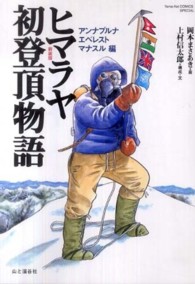- ホーム
- > 洋書
- > 英文書
- > History / World
Full Description
A new look at the drama that lay behind the end of the war in the Pacific
Signed on September 2, 1945 aboard the American battleship USS Missouri in Tokyo Bay by Japanese and Allied leaders, the instrument of surrender that formally ended the war in the Pacific brought to a close one of the most cataclysmic engagements in history. Behind it lay a debate that had been raging for some weeks prior among American military and political leaders. The surrender fulfilled the commitment that Franklin Roosevelt had made in 1943 at the Casablanca conference that it be "unconditional." Though readily accepted as policy at the time, after Roosevelt's death in April 1945 support for unconditional surrender wavered, particularly among Republicans in Congress, when the bloody campaigns on Iwo Jima and Okinawa made clear the cost of military victory against Japan. Germany's unconditional surrender in May 1945 had been one thing; the war in the pacific was another. Many conservatives favored a negotiated surrender.
Though this was the last time American forces would impose surrender unconditionally, questions surrounding it continued through the 1950s and 1960s--with the Korean and Vietnam Wars--when liberal and conservative views reversed, including over the definition of "peace with honor." The subject was revived during the ceremonies surrounding the 50th anniversary in 1995, and the Gulf and Iraq Wars, when the subjects of exit strategies and "accomplished missions" were debated. Marc Gallicchio reveals how and why the surrender in Tokyo Bay unfolded as it did and the principle figures behind it, including George C. Marshall and Douglas MacArthur. The latter would effectively become the leader of Japan and his tenure, and indeed the very nature of the American occupation, was shaped by the nature of the surrender. Most importantly, Gallicchio reveals how the policy of unconditional surrender has shaped our memory and our understanding of World War II.
Contents
Introduction: A Great Victory Has Been Won
Chapter I: "Our Demand has been and it remains-Unconditional Surrender!"
Chapter II: "Popular opinion can offer no useful contribution."
Chapter III. "[Admiral Leahy] said that his matter had been considered on a political level and consideration had been given to the removal of the sentence in question."
Chapter IV: "I deem this reply a full acceptance of the Potsdam Declaration which specifies the unconditional surrender of Japan."
Chapter V: "[T]he surrender today is no negotiated surrender. The Japanese are submitting to superior force now massed here."
Chapter VI: "We demanded unconditional surrender, then dropped the bomb and accepted conditional surrender..."
Chapter VII: "The curators simply will not let go of the notion that the policy of demanding Japan's unconditional surrender was (a) unreasonable, (b) prolonged the war needlessly, and foiled Japan's earnest desire to make peace."
Conclusion: "Much of the success of the occupation derived from the fact that Japan surrendered unconditionally, thereby ceding absolute and nonnegotiable authority to the victors."







